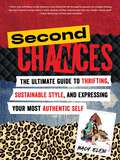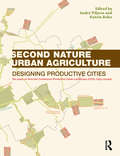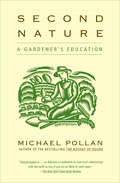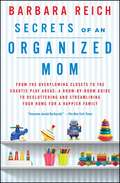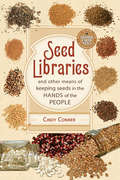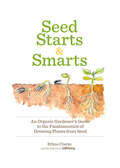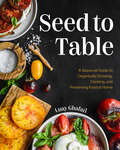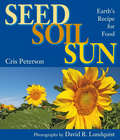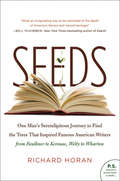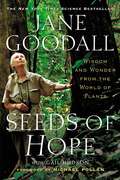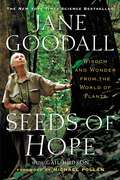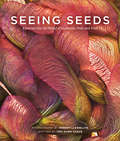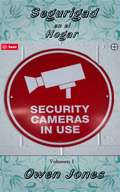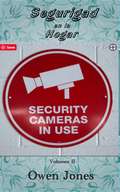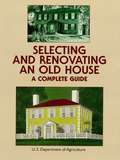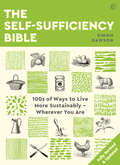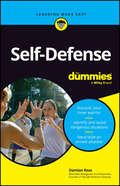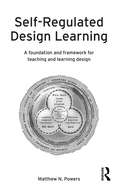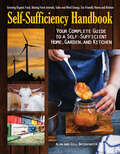- Table View
- List View
Second Chances: The Ultimate Guide to Thrifting, Sustainable Style, and Expressing Your Most Authentic Self
by Macy EleniBecome a thrifting queen and discover the exciting world of secondhand shopping with this comprehensive guide from TikTok style star Macy Eleni. Macy Eleni is a thrifting expert. Bargain hunting since she was a teen who was short on cash and long on a desire to express herself, she knows that staying on trend without breaking the bank—or increasing your carbon footprint—is not only easy, but also thrilling. Second Chances is a unique guide to a one-of-a-kind, circular wardrobe. Eleni&’s superpower is sniffing out great finds and here she walks you through the art of in-person discovery at thrift stores and vintage shops, estate sales and flea markets, yard sales and antique stores—and online resale platforms. This book will teach you how to organize your existing wardrobe, evaluate pieces you find, and manifest your dream closet. After more than a decade as a thrifting expert, Macy has compiled every tip and trick in the second-hand shopping world from sizing and repairing to tailoring and cleaning—this book covers it all. Macy also calls on other thrifting experts of diverse backgrounds to share advice about how to navigate a fashion landscape with regard to body type, gender, and ethnicity, so you can easily seek out the clothes that speak to your unique identity. Whether you&’re a seasoned thrifter or just getting started, this book will be your go-to guide for looking your best, feeling your best, and giving clothes the second and third lives they deserve!
Second Nature Urban Agriculture: Designing Productive Cities
by André Viljoen Katrin BohnWinner of the 2015 RIBA President's Award for Outstanding University Located Research This book is the long awaited sequel to "Continuous Productive Urban Landscapes: Designing Urban Agriculture for Sustainable Cities". "Second Nature Urban Agriculture" updates and extends the authors' concept for introducing productive urban landscapes, including urban agriculture, into cities as essential elements of sustainable urban infrastructure. It reviews recent research and projects on the subject and presents concrete actions aimed at making urban agriculture happen. As pioneering thinkers in this area, the authors bring a unique overview to contemporary developments and have the experience to judge opportunities and challenges facing those who wish to create more equitable, resilient, desirable and beautiful cities.
Second Nature: A Gardener's Education (Bloomsbury Paperbacks Gardening Classics Ser.)
by Michael PollanChosen by the American Horticultural Society as one of the seventy-five greatest books ever written about gardening, Second Nature has become a manifesto for rethinking our relationship with nature. With chapter ranging from a reconsideration of the Great American Lawn and a dispatch from one man’s war with a woodchuck to reflections on the sexual politics of roses, Pollan captures the rhythms of our everyday engagement with the outdoors in all its glory and exasperation.
Secret Medicines from Your Garden: Plants for Healing, Spirituality, and Magic
by Ellen Evert HopmanA guided exploration of herbal lore and healing plants found in yards, forests, meadows, and hedgerows• Draws on traditional knowledge and remedies from around the world, including Native American, Celtic, and Egyptian traditions• Provides simple recipes to safely make herbal remedies from local plants and honey for first aid, immune support, and treatment of common ailments• Details the “triangle” formula-making system of William LeSassier• Explains how to work with plant spirits, herbal astrology, and Animal Spirit MedicineWeaving together ancient wisdom, mystical folklore, and modern plant research, master herbalist Ellen Evert Hopman explores the many uses of flowers, trees, common weeds, and ornamental plants for food, medicine, spiritual growth, and magical rituals. She reveals the herbal lore surrounding each plant, drawing on traditional knowledge and remedies from around the world, including Native American, Celtic, and Egyptian traditions. She includes recipes throughout so you can make medicines from wild and domesticated plants easily found in yards, forests, meadows, and hedgerows, and she discusses what to plant to ensure you have leaves, berries, and flowers all year.The author reveals how to quickly intuit an unknown plant’s properties using the signatures of plants--universal indications and contraindications based on the form, color, and location of a plant. She includes an in-depth section on honey and Bee Medicine, allowing you to appreciate the labors of these plant-dependent insects. Exploring the magical role of herbs in ancient ritual, Hopman provides recipes for Egyptian temple incense and their sacred medicine known as “Kyphi” or “Kaphet,” used to purify the body, banish insomnia, and promote vivid dreaming. She explores shamanic Plant Spirit and Animal Spirit Medicine as well as herbal astrology. She also explains the “triangle” formula-making system of her herbal mentor William LeSassier to help you develop custom herbal remedies tailored to a person’s unique strengths and weaknesses.Showing how to easily incorporate wild plants into your life to receive their healing benefits throughout the seasons, Hopman reveals the power of the bounty that Mother Nature has provided right at our doorstep.
Secrets of Great Second Meals: Flexible Modern Recipes That Value Time and Limit Waste
by Sara DickermanA James Beard award winner offers ‘‘an invitation to ‘start riffing with the contents of your refrigerator’ and encourage a new perspective on leftovers’’ (Publishers Weekly).When it comes to leftovers, Sara Dickerman believes that there is nothing better than figuring out the right way to reframe a good meal into another, potentially great meal. Second meals aren’t just reheating last night’s dinner. At Sara’s house, re-invention might mean pureeing roasted vegetables into a quick soup, crafting a beautiful salad with some second-day salmon, or stuffing cooked rice into roasted poblano peppers. But unlike other cookbooks that emphasize thrift, Secrets of Great Second Meals focuses on creating inviting, sophisticated, and healthy recipes that are flexible enough to adapt to what you have on hand.Sara shows how to make the most of your food the way chefs do. With a little planning, you can look at extra food from one dinner as components to another meal that has already been prepped. Sara provides a list of the top ten most versatile dishes for multiple meals, offers advice on food storage, and includes tips on adding freshness and flavor using salt, acids, herbs, and texture. Most importantly, she gives home cooks the tools they need to improvise confidently.Illustrated with full-color photos, Secrets of Great Second Meals makes re-imagining food for a second meal not just a good, cheap, waste-reducing thing to do, but way of making every day eating more inventive and enticing.“[For] anyone who has ever looked quizzically at a container of leftovers while trying to plan a new meal will find what they’re looking for.” —Booklist
Secrets of an Organized Mom: From the Overflowing Closets to the Chaotic Play Areas: A Room-by-Room Guide to Decluttering and Streamlining Your Home for a Happier Family
by Barbara ReichMom&’s Choice Awards Gold Award Recipient Professional organizer Barbara Reich offers a life-changing program—focused on decluttering and streamlining your home—that helps families live simpler, less chaotic lives: &“Everyone should Barbarafy,&” raves The New York Times.Mothers can feel like life is one never-ending loop. Just when one problem or responsibility is overcome, another one trips us up. But help is on the way: Barbara Reich has all the strategies for staying ahead of the curve—and she’s wrapped them up into four easy steps that can be applied to any organizing project: purge, design, organize, and maintain. The keys to Barbara’s success are simplicity and consistency. Room by room, she goes through the most problematic areas in the home—from the tornado-struck play area to the packed basement or storage unit—and approaches organizing in manageable bites. In addition to cleaning and organizing tips, she talks about how to avoid social overload, preaching the power of “No”—for example, when your child wants to attend six birthday parties in one weekend. As the mother of thirteen-year-old twins, Barbara offers insight into the lives of crazed moms as only a mother could. Combining the humor of a sympathetic friend and the no-nonsense advice of a true type-A personality, Reich offers clever, appealing solutions that are genuinely achievable for everyone.
Secrets of the Garden: Food Chains and the Food Web in Our Background
by Kathleen Weidner ZoehfeldPerfect for Earth Day and spring planting season--an outstanding book about backyard science the whole family will appreciate. Alice's family plants a vegetable garden each spring, and this budding naturalist reports all she sees about how the plants grow, what insects come to eat the plants, and what birds and animals come to eat the insects. It's the food chain, right in her own backyard! While Alice's narrative is simple and engaging, science concepts are presented in more depth in sidebars by a pair of very knowledgeable (and highly amusing) chickens! Noted science writer Kathleen Weidner Zoehfeld knows how to layer information to make it accessible to a wide range of readers and useful for educators. And illustrator Priscilla Lamont's funny, friendly paintings make this a garden everyone will want to explore. Kids will eat up this wonderful book of backyard science—and perhaps they'll even be inspired to eat their vegetables!
Seed Libraries: And Other Means of Keeping Seeds in the Hands of the People
by Cindy ConnerHistorically, seed companies were generally small, often family-run businesses. Because they were regionally based, they could focus on varieties well-suited to the local environment. <P><P>A Pacific Northwest company, for example, would specialize in different cultivars than a company based in the Southeast. However the absorption of these small, independent seed businesses into large multinationals, combined with the advancement of biotechnology resulting in hybrids and GMO seeds, has led to a serious loss of genetic diversity. The public is now at the mercy of the corporations that control the seeds.In the past few years, gardeners have realized the inherent danger in this situation. A growing movement is striving to preserve and expand our stock of heritage and heirloom varieties through seed saving and sharing opportunities. Seed Libraries is a practical guide to saving seeds through community programs, including: Step-by-step instructions for setting up a seed library A wealth of ideas to help attract patrons and keep the momentum going Profiles of existing libraries and other types of seed saving partnershipsWhoever controls the seeds controls the food supply. By empowering communities to preserve and protect the genetic diversity of their harvest, Seed Libraries is the first step towards reclaiming our self-reliance while enhancing food security and ensuring that the future of food is healthy, vibrant, tasty, and nutritious.Cindy Conner is a permaculture educator, founder of Homeplace Earth and producer of two popular instructional gardening DVDs. She is also the author of Grow a Sustainable Diet.
Seed Starts & Smarts: An Organic Gardener's Guide to the Fundamentals of Growing Plants from Seed
by Organic Gardening Ethne ClarkeWhether broadcast across a prepared seedbed or tucked into a container of growing medium, seeds hold the promise of something much bigger--juicy tomatoes, lush foliage, and brilliant blossoms. And growing plants from seed is easy and inexpensive (as well as rewarding) for the gardener ready to try new or regional varieties. Seed Starts & Smarts features sowing and growing advice for more than 70 edible garden crops--including vegetables, herbs, and fruits--along with tips and techniques for growing the most popular ornamentals from seed, region-specific information, and general timing guidelines.
Seed to Table: A Seasonal Guide to Organically Growing, Cooking, and Preserving Food at Home
by Luay GhafariA Seasonal Guide for Growing & Cooking Foods Right at Home“Luay makes growing your own food, even if just a small amount, into an achievable endeavor.”—Niki Irving of Flourish Flower Farm, flower farmer, florist, author of Growing Flowers#1 Best Seller in Organic GardeningLearn to garden in any space with Seed to Table, grow and cook nutrient-dense foods to take your gardening and cooking to the next level!Gardening, cooking, and eating done right!Seed to Table focuses on how to feed your family with nutritious foods from your own outdoor, home and/or kitchen garden. Whether you live in a city or in the country, this book gives you tools on effective growing techniques, seed starting methods, and garden maintenance. Organic gardening for every individual style! Have fun while you create your own gardening system whether it be for a container garden or a kitchen garden. Try out big and small garden ideas to stock up your fridge with delicious fruits, vegetables, and herbs to grow your self-sufficiency. Maximize your minimal or large space with impactful practices that are perfect for anyone on a sustainability and self-sufficiency journey.Inside Seed to Table, you’ll find:A full and in-depth guide on preserving foods while cultivating homegrown foodsEasy and delicious vegetable-forward recipes and preservation techniques to feed your whole familyEffective urban gardening tools to create a garden in a patio garden, rooftop space, or any spaceIf you're looking for books on urban gardening or gardening in any space, add this book to your collection! If you liked Plants-Only Kitchen, Holistic Homesteading, or Raised-Bed Gardening for Beginners, then you’ll love Seed to Table.
Seed, Soil, Sun: Earth's Recipe for Food
by Cris Peterson David R. LundquistSeed, Soil, Sun. With these simple ingredients, nature creates our food. Once again, noted author Cris Peterson brings both wonder and clarity to the subject of agriculture, celebrating the cycle of growth, harvest, and renewal. Using the corn plant as an example, she takes the reader through the story of germination and growth of a tiny corn seed into a giant plant reaching high into the air, with roots extending over six feet into the ground. This American Farm Bureau Foundation's Agriculture Book of the Year also discusses the make-up of soil and the amazing creatures who live there--from microscopic one-celled bacteria to moles, amoebas, and earthworms. David Lundquist's stunning photographs bring an immediacy and vibrancy to the seemingly miraculous process.
Seeds
by Richard HoranFrom the wooded road made of golden hemlock running past L. Frank Baum's childhood home to the lonely stump of Scout's oak in Harper Lee's Alabama, author Richard Horan gathers tree seeds-and stories-from the homes of America's most treasured authors. At once a heartfelt paean to literature and a wise, funny, and uplifting account of one man's reconnection with nature, Seeds celebrates Horan's triumphs and calamities on his quest to link trees with great writers-a delightfully original meditation on the nature of inspiration and a one-of-a-kind adventure into literature.
Seeds of Hope
by Jane Goodall Gail HudsonRenowned naturalist and bestselling author Jane Goodall examines the critical role that trees and plants play in our world. In her wise and elegant new book, Jane Goodall blends her experience in nature with her enthusiasm for botany to give readers a deeper understanding of the world around us.Long before her work with chimpanzees, Goodall's passion for the natural world sprouted in the backyard of her childhood home in England, where she climbed her beech tree and made elderberry wine with her grandmother. The garden her family began then, she continues to enjoy today. SEEDS OF HOPE takes us from England to Goodall's home-away-from-home in Africa, deep inside the Gombe forest, where she and the chimpanzees are enchanted by the fig and plum trees they encounter. She introduces us to botanists around the world, as well as places where hope for plants can be found, such as The Millennium Seed Bank, where one billion seeds are preserved. She shows us the secret world of plants with all their mysteries and potential for healing our bodies as well as Planet Earth.Looking at the world as an adventurer, scientist, and devotee of sustainable foods and gardening-and setting forth simple goals we can all take to protect the plants around us-Jane Goodall delivers an enlightening story of the wonders we can find in our own backyards.
Seeds of Hope: Wisdom and Wonder from the World of Plants
by Jane Goodall Michael Pollan Gail HudsonRenowned naturalist and bestselling author Jane Goodall examines the critical role that trees and plants play in our world. In her wise and elegant new book, Jane Goodall blends her experience in nature with her enthusiasm for botany to give readers a deeper understanding of the world around us.Long before her work with chimpanzees, Goodall's passion for the natural world sprouted in the backyard of her childhood home in England, where she climbed her beech tree and made elderberry wine with her grandmother. The garden her family began then, she continues to enjoy today. SEEDS OF HOPE takes us from England to Goodall's home-away-from-home in Africa, deep inside the Gombe forest, where she and the chimpanzees are enchanted by the fig and plum trees they encounter. She introduces us to botanists around the world, as well as places where hope for plants can be found, such as The Millennium Seed Bank, where one billion seeds are preserved. She shows us the secret world of plants with all their mysteries and potential for healing our bodies as well as Planet Earth.Looking at the world as an adventurer, scientist, and devotee of sustainable foods and gardening-and setting forth simple goals we can all take to protect the plants around us-Jane Goodall delivers an enlightening story of the wonders we can find in our own backyards.
Seeing Seeds: A Journey into the World of Seedheads, Pods, and Fruit (Seeing Series)
by Robert Llewellyn Teri Dunn Chace“Llewellyn’s images reflect a depth of detail that until now, only the best botanical illustrators could approach.” —The Washington Post A centuries-old saying goes, “Great oaks from little acorns grow.” But as this dazzling book reveals, there is much more to a seed than the plant it will someday become: seeds, seedheads, pods, and fruits have their own astounding beauty that rivals, and sometimes even surpasses, the beauty of flowers. Bitter melon seeds resemble a handful of rubies. Poppy pods could be art nouveau salt shakers. And butterfly vine seeds look exactly like those delicate insects captured in mid-flight. Seeds also come with fascinating stories. Jewels of Opar got its name from a fabled city in Edgar Rice Burroughs’s Tarzan stories. Lotus seeds sent into orbit by Chinese scientists came back to earth mysteriously altered. And fava beans—beloved of foodies—have a Jekyll-and-Hyde personality: they can cause the debilitating condition known as favism in some individuals and at the same time combat the microorganism that causes malaria. In these stunning pages you’ll gain an understanding of how seeds are formed and dispersed, why they look the way they do, and how they fit into the environment. Seeing Seeds will take you to strange and wonderful places. When you return, it’s safe to say that you’ll never look at a seed the same way again.
Seeing Trees: Discover the Extraordinary Secrets of Everyday Trees (Seeing Series)
by Nancy Ross Hugo Robert LlewellynHave you ever looked at a tree? That may sound like a silly question, but there is so much more to notice about a tree than first meets the eye. Seeing Trees celebrates seldom seen but easily observable tree traits and invites you to watch trees with the same care and sensitivity that birdwatchers watch birds. Many people, for example, are surprised to learn that oaks and maples have flowers, much less flowers that are astonishingly beautiful when viewed up close. Focusing on widely grown trees, this captivating book describes the rewards of careful and regular tree viewing, outlines strategies for improving your observations, and describes some of the most visually interesting tree structures, including leaves, flowers, buds, leaf scars, twigs, and bark. In-depth profiles of ten familiar species—including such beloved trees as white oak, southern magnolia, white pine, and tulip poplar—show you how to recognize and understand many of their most compelling (but usually overlooked) physical features.
Seguridad en el Hogar: Vol. 1 (Como hacer... #33)
by Owen JonesSeguridad en el Hogar Volumen1 La información en este ebook sobre varios aspectos de la protección de su familia y el hogar y las ideas relacionadas se organiza en 15 capítulos de alrededor de 500-600 palabras cada uno. Espero que les interese a aquellos que se preocupan por su seguridad. Como bono adicional, le doy permiso para usar el contenido de su propio sitio web o de sus propios blogs y boletines, aunque es mejor que los reescriba primero con sus propias palabras. También puedes dividir el libro y revender los artículos. De hecho, el único derecho que no tienes es el de revender o regalar el libro tal como le fue entregado. Palabras clave: Seguridad en el Hogar, Prevención, Prevención en el Hogar, Antivirus, Alarmas Antirrobo, Alarmas de Incendio, Bricolaje.
Seguridad en el Hogar: Volumen II (Cómo hacer... #20)
by Owen JonesHola y gracias por comprar este ebook llamado 'Home Security Systems II'. Espero que la información te resulte provechosa, útil y rentable. La información en este ebook sobre varios aspectos de la protección de su familia y el hogar y las ideas relacionadas se organiza en 15 capítulos de alrededor de 500-600 palabras cada uno. Espero que les interese a aquellos que se preocupan por la seguridad de su familia, su hogar y sus posesiones. Como bono adicional, te doy permiso para usar el contenido de tu propio sitio web o de tus propios blogs y boletines, aunque es mejor que los reescribas primero con tus propias palabras. También puede dividir el libro y revender los artículos. De hecho, el único derecho que no tienes es el de revender o regalar el libro tal como te fue entregado. Palabras clave: seguridad en el hogar, alarmas antirrobo, prevención de delitos, protección en el hogar, seguridad en el hogar, alarmas contra intrusos, modificaciones en el hogar
Seismic Resistance of Vernacular Timber Frames with Infills: Case Studies from Japan and Romania
by Andreea Dutu Yoshihiro YamazakiThis book provides an engineer’s perspective on the traditional construction methods for timber frames with infills, focusing on traditional paianta houses in Romania and minka houses in Japan to provide insights into the construction, seismic behavior, and design considerations of such structures.The nuances of each country’s traditional construction methods are considered, as well as the shared seismic culture and the similar functionality and local materials used for the houses, plus challenges from earthquake loading and fire. The efforts to preserve traditional houses in Romania are contrasted with Japan’s regulatory framework for traditional residential construction methods. Strengthening solutions are also proposed for timberframed houses with infills, considering various causes of degradation.• Introduces examples from non- seismic and seismic- prone countries.• Provides a comparative analysis of worldwide examples.• Presents design examples illustrating the integration of traditional architecture with modern design standards.The book serves as a comprehensive guide to the engineering intricacies of traditional houses in Romania and Japan for engineers and architects, with practical applications for new constructions worldwide.
Selected Tips from Heloise
by HeloiseThis book contains many useful hints for making our lives easier. I can vouch for the effectiveness of this one: To get rid of ants, wipe down counters and other surfaces with vinegar. It will take four or five days to discourage the ants. Broken glass? "To sweep up broken glass, place a damp paper towel over the debris first. The tiny shattered pieces will cling to the paper and all can be easily swept up. Works with pet hair, too." Do you have "big terry cloth oven mitts? Great for wiping splatters off kitchen walls, the terry cloth loops scrub right into the depressions in textured paint. They also scrub vinyl floors in a flash --a huge area wipes clean in one swipe. In addition, the mitts slurp up spills, do dusting, and, if slightly dampened, pick up pet hairs from upholstery." Some items keep better in the refrigerator if turned upsidedown--jelly, relish, pickles. Be sure lids are tight. When finished, throw the mitts into the washer-- they come out clean and ready for
Selecting and Renovating an Old House: A Complete Guide
by U.S. Dept. of AgricultureClear, thoughtfully written manual tells how to appraise worthiness of an older home, develop plans for remodeling the kitchen, adding a bath, replacing floors, roof, windows, doors, interior walls, kitchen cabinets, and much more. Full glossary of housing terms and 157 illustrations clarify an extremely detailed text.
Self Sufficiency Bible
by Simon DawsonIn today's economic climate, self-sufficiency is increasingly seen as a viable means of taking control of our lives and safeguarding for the future - this is the book that will help every householder do just that. Each of the twelve chapters focuses on key topics for living a more self-sustainable life, with practical information and expert guidance that will make the subject come alive for everyone, whatever their needs, circumstances and resources. This means that the gardening chapter, for example, is appropriate both for people with an urban back yard or a more substantial plot of land. Written in a down-to-earth, engaging and often amusing style, the book will appeal to single people as much as to those with large families, to women who want to be more creative, resourceful and independent, to men who want to rediscover their inner 'hunter-gatherer', and to parents looking to equip their children with basic life skills.
Self-Defense For Dummies
by Damian RossGet street-smart. Unleash your inner warrior. Forget everything you thought you knew about self-defense. Those graceful martial arts moves that are so effective in the movies are likely to get you killed on the street. In fight-or-flight mode, you won’t have the calm thinking and fine motor skills to execute them. You need a simpler approach with a few fundamental moves that are easy to remember and perform yet devastating to an attacker. The solution? Self-Defense For Dummies, your guide to avoiding attacks, neutralizing attackers, and protecting yourself and your loved ones. In this book, you discover a self-defense system that works in the real world, where armed criminals target the most vulnerable and don’t fight fair. Discover strategies to make yourself a hard target, as opposed to an easy one Heighten your awareness of your surroundings and potential threats Sharpen your self-defense instincts and respond proactively to impending danger Master hand-to-hand combat basics and defend against grabs and holds Learn how to use weapons and defend against them
Self-Regulated Design Learning: A Foundation and Framework for Teaching and Learning Design
by Matthew N. PowersSelf-Regulated Design Learning: A Foundation and Framework for Teaching and Learning Design reframes how educators in architecture, landscape architecture, and other design disciplines think about teaching and learning design. The book weaves together concepts of constructivism, social cognitive theory, and self-regulated learning into a solid theoretical foundation for innovative teaching that emphasizes meaning, memory, problem solving, and mastery. The central goal of self-regulated design learning is making design learnable so that students are encouraged to become active, engaged participants in the design learning process. Key features of the book include: examining the issues, values, and challenges of teaching and learning in design, exploring select educational theories and concepts relevant to design pedagogy, illustrating the pivotal relationships between design learning and self-regulation, and discussing pedagogic techniques that support self-regulated design learning and lead to greater student achievement and performance. Self-Regulated Design Learning: A Foundation and Framework for Teaching and Learning Design provides numerous examples and applications to help design educators understand how to implement the self-regulated design learning methodology in their studios. Through this book, design educators will discover new ways of encouraging meaningful design learning through an advanced approach that is empowering, inspiring, and vital.
Self-Sufficiency Handbook: Your Complete Guide to a Self-Sufficient Home, Garden, and Kitchen
by Gill Bridgewater Alan BridgewaterWhether you&’re looking to adopt a greener lifestyle or wanting to go off the grid, this guide has all you need to know to boost your self-sufficiency. Worried about ever-rising fuel bills and longing for the day when you can be off-grid and independent? Anxious about the quality of the food you eat and planning to go organic? Yearning to get back to the way it was but don&’t know where to start? This book will show you how to achieve the eco-friendly good life. The authors cover the ecological gamut from geothermal heating to crop rotation to soap making. They answer important questions like how much land is really needed to be self-sufficient, whether or not to depend entirely on natural forms of energy, and which farm animals will best meet your needs. There&’s practical information here on building an insulated flue pipe chimney, identifying edible wild plants, and composting with worms—as well as recipes for jams, rhubarb wine, cheeses, and more. Packed with full-color photographs, helpful illustrations, and diagrams, Self-Sufficiency Handbook will appeal to urban dwellers who want to adopt certain aspects of greener living and to serious adherents of back-to-basics living.Inside Self-Sufficiency Handbook, you&’ll find: –Inspirational yet practical introduction to a greener way of living –Essential reading for anyone considering a shift to a more self-sufficient lifestyle, no matter how small the change –Emphasis is on the positive aspects of self-sufficiency, such as cutting living costs and eating well –Covers everything from fitting a wind turbine to making honey from your own beehives. –Step-by-step instructions on keeping animals, growing organic food, and preserving your own produce –Guidelines for creating a self-sufficient home and eco-friendly home improvements&“This book shows that self-sufficiency is not only better for the planet—it&’s cheaper and more rewarding!&” —Green Rewards/Sustainability Advisory Panel
